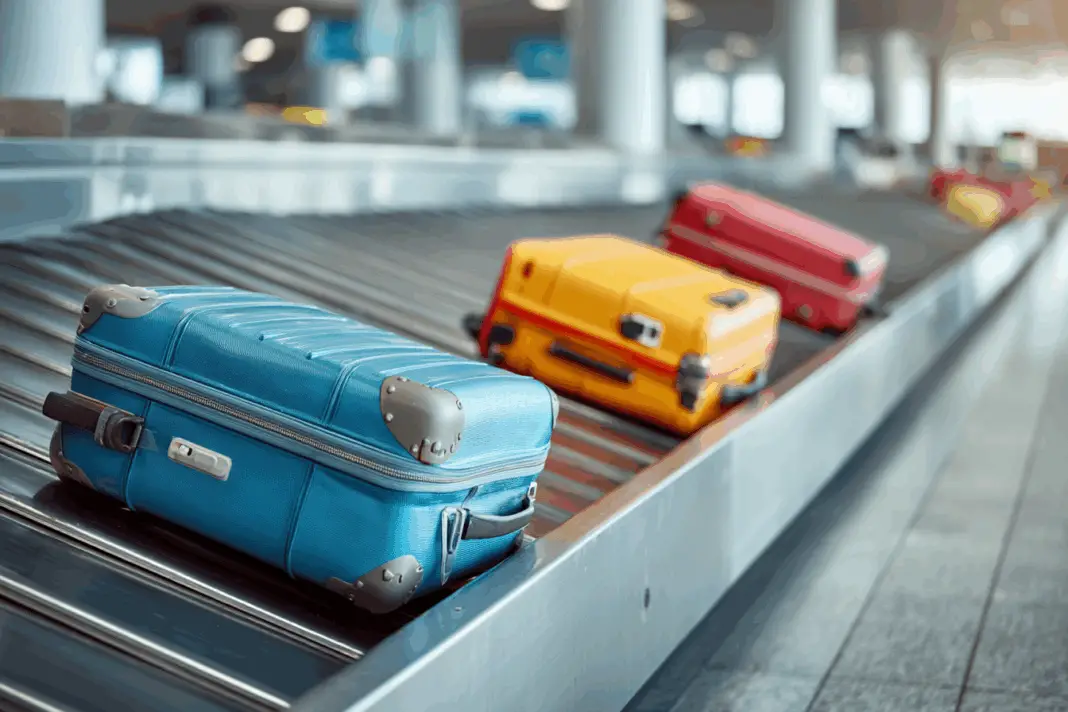Standing at the baggage carousel watching other passengers grab their suitcases and walk away while yours remains mysteriously absent ranks among travel’s most frustrating experiences. The good news? Airport insiders and frequent flyers have discovered several reliable methods to dramatically increase the chances of seeing your luggage appear first on that spinning belt. These strategies range from simple timing tricks to clever tagging techniques that work surprisingly well.
Check in your bags as late as possible
Most travelers assume checking in early gives them better service, but airport workers know the opposite is true. Thomas Lo Sciuto, a ramp worker and gate agent at a regional US airport, explains that bags checked closer to departure time get loaded onto the plane last. This creates the perfect “last in, first out” scenario that works in your favor. The loading process follows a systematic front-to-back pattern on baggage carts, so late-checked bags end up in the final cart.
The key is timing this strategy carefully without cutting it too close to your departure. Most airlines require checked bags to arrive at least 45 minutes before takeoff, so plan accordingly. Late-checked bags typically occupy the top positions in cargo holds, making them easily accessible when ground crews begin unloading at your destination. This simple timing adjustment can save significant waiting time at baggage claim, especially during busy travel periods when carousels overflow with hundreds of suitcases.
Request fragile stickers from airline staff
Airport staff willingly provide free “fragile” stickers upon request, and these simple labels can dramatically improve your bag’s carousel position. Baggage handlers treat fragile items with extra care, typically placing them on top of other luggage during loading and ensuring they’re among the first items unloaded. This preferential treatment stems from airlines’ desire to minimize damage claims on delicate items. The stickers cost nothing but can save considerable time waiting at baggage claim.
However, security experts warn against including your home address on luggage tags when using this strategy. Opportunistic thieves can identify travelers who are away from home and potentially target their properties for burglary. Instead, use your phone number, email address, or work address on luggage tags. The fragile sticker technique works particularly well on international flights where baggage handling involves multiple transfers and longer processing times.
Fly first class for priority luggage handling
Premium cabin passengers receive automatic priority baggage tags that guarantee expedited handling throughout the entire process. Airlines load first-class luggage last and unload it first, often using separate baggage carts dedicated exclusively to premium passengers. This systematic separation ensures priority bags avoid getting buried beneath hundreds of economy-class suitcases. The priority tag system represents one of the few remaining perks that airlines consistently honor across all destinations and aircraft types.
Baggage for first-class passengers often travels on separate carts and gets sorted for fast delivery at destination airports. While first-class tickets cost significantly more than economy fares, frequent business travelers and those using airline miles for upgrades can take advantage of this reliable benefit. The priority handling extends beyond just carousel position – premium bags also receive preferential treatment during connections and weather delays, reducing the likelihood of lost luggage.
Gain frequent flyer elite status benefits
Airlines reward their most loyal customers with priority baggage handling regardless of ticket class. Elite status members receive special baggage tags that trigger preferential treatment throughout airport systems. These tags signal baggage handlers and automated sorting systems to prioritize those specific suitcases during loading and unloading procedures. Many travelers don’t realize that elite benefits extend far beyond seat upgrades and boarding priority to include significant baggage handling advantages.
Airlines often tag frequent flyer bags differently, making it easier for systems and handlers to separate them from regular luggage. The good news is that elite members don’t need to book premium seats to enjoy priority baggage benefits – even basic economy tickets receive preferential baggage handling when booked by status holders. This represents excellent value for travelers who fly the same airline frequently and can qualify for elite status through mileage accumulation or credit card partnerships.
Take advantage of gate checking opportunities
When flights are completely full and overhead bin space becomes scarce, gate agents often offer free gate checking for carry-on bags. This presents an excellent opportunity to bypass regular baggage handling and get your luggage back quickly upon arrival. Gate-checked bags typically get loaded last since they’re collected just before departure, positioning them perfectly for first-off-the-plane retrieval. The process works especially well on smaller domestic flights where space limitations are common.
Gate checking does come with some limitations – bags must comply with carry-on restrictions, meaning no large liquids or prohibited items. On some regional flights, gate-checked bags get returned at the jet bridge immediately upon arrival, eliminating baggage claim entirely. However, on larger aircraft, these bags often end up on the regular carousel but maintain their priority positioning from last-minute loading. The key is being flexible and taking advantage of gate checking opportunities when they arise.
Purchase priority tags through airline services
Many airlines sell priority baggage tags as standalone services, even for economy-class passengers. These tags typically cost between $15-30 per bag but guarantee expedited handling similar to what first-class passengers receive automatically. Some premium credit cards also provide complimentary priority baggage handling as a cardholder benefit, making this option accessible without additional fees. The investment often pays off during busy travel periods when regular baggage claim can take 30-45 minutes or longer.
Priority tag services work consistently across different airlines and airports because they integrate with existing baggage handling systems. Unlike informal tricks that depend on individual handler discretion, purchased priority services create official documentation that automated systems recognize and process accordingly. Bags marked priority are often placed on top of other luggage and loaded last, ensuring they come off first at destinations. This represents a middle ground between expensive first-class tickets and hoping that free tricks work reliably.
Choose smaller airports when possible
Airport size directly impacts baggage handling speed and efficiency. Smaller regional airports typically process luggage much faster than major hubs due to lower passenger volumes and more streamlined operations. These airports often feature newer, more efficient baggage systems that can sort and deliver luggage more quickly than older hub facilities dealing with massive daily volumes. When flight options allow flexibility, choosing smaller airports can significantly reduce baggage claim waiting times regardless of which carousel position your bag occupies.
Larger hub airports often have longer baggage processing times due to sheer volume, while smaller facilities can deliver bags faster across the board. Modern regional airports frequently invest in upgraded automated systems that move luggage more efficiently than older hub infrastructure. Additionally, smaller airports typically have shorter distances between aircraft parking positions and baggage claim areas, reducing transport time. This advantage applies to all passengers, making it an excellent strategy when planning flexible itineraries.
Understand airline baggage processing systems
Modern baggage handling relies heavily on automated systems that can process enormous daily volumes – Delta alone handles nearly 400,000 checked bags per day. These systems use barcode scanning and conveyor networks to sort luggage based on various priority codes embedded in bag tags. Understanding this process helps travelers make informed decisions about check-in timing and tag requests. The complexity of these operations means that small changes in how bags enter the system can have significant impacts on carousel positioning.
Contrary to popular belief, paying for checked luggage through basic economy tickets doesn’t deprioritize bags once they enter the handling system. The automated processing treats all bags equally based on check-in timing, priority tags, and passenger status rather than fare class. This means that strategic timing and tag requests can be equally effective regardless of ticket type. Understanding these system mechanics empowers travelers to make better decisions about luggage handling strategies that actually work within airport operations.
Avoid common luggage tagging mistakes
Many travelers unknowingly sabotage their luggage handling by making simple tagging errors. Using home addresses on luggage tags creates security risks while providing no benefit for baggage handling speed. Old airline tags from previous flights can confuse automated scanning systems and delay processing. Overly decorative or bulky luggage accessories can interfere with conveyor systems and cause handling delays. These seemingly minor details can significantly impact how quickly bags move through airport systems.
Professional travelers recommend using phone numbers and email addresses on luggage tags instead of home addresses for security reasons. Removing old tags prevents scanning confusion and ensures current flight information processes correctly. Simple, streamlined luggage appearance helps automated systems handle bags more efficiently throughout the sorting process. These basic precautions complement priority strategies by ensuring bags move smoothly through airport systems without unnecessary delays or complications that could override priority positioning.
Getting your luggage first requires understanding how airport baggage systems actually work rather than relying on travel myths. The most effective strategies focus on timing, official priority services, and avoiding common mistakes that slow down processing. Whether through late check-in timing, fragile stickers, or purchased priority tags, these proven methods can transform the baggage claim experience from frustrating wait to quick retrieval.

